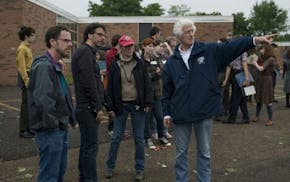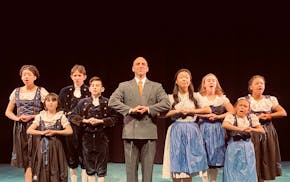Every spring, 11th graders from Albert Lea High School spend a few weeks trying on the lifestyles of their great-great-something-grandparents.
At nearby Historical Village, a collection of buildings maintained by the Freeborn County Historical Society, students spend time in a blacksmith shop, a one-room schoolhouse, a parsonage, a shoe-repair shop. They churn butter, plant corn by hand, pack mud in the crevices of log-cabin walls to keep the critters out. They come up with their own old-fashioned activities — one year they made waffles from an 1856 recipe.
For the finale, the high schoolers don vests and bonnets and other period clothing and spend two days on the site presenting lessons of their own devising to all of Freeborn County's fifth-graders.
"My kids get to taste, touch and feel history," said Jim Haney, an Albert Lea High School social studies teacher who oversees the project. Haney was named Minnesota History Teacher of the Year in 2012, an honor he says owes much to the fact that "I've got a local museum that's a mile down the road and it's got a village and they're allowing me to work with documents and items that are priceless."
Museums are increasingly coming to the rescue to enhance classroom lessons, as schools struggle to do more with less money, said Joe Alfano, K-5 STEM (science, technology, engineering and math) coordinator for Minneapolis public schools. Nationally, museums invest more than $2 billion a year in educational programming, mostly for K-12 students, according to the American Alliance of Museums.
"What museums offer us are those authentic and deep content-rich experiences," Alfano said. "We do a lot of abstract learning, but it has to have a foundation of something real to grow into something meaningful and deep."
It's a natural pairing. Museums offer expertise, primary sources and priceless artifacts — often up-close.
Students in the Science Museum of Minnesota's Real Dinosaur Experience don't just gaze up at skeletons from behind ropes — they get to hold dinosaur teeth in their hands and analyze the dental differences between carnivores and herbivores.
Museum staffs pay close attention to curriculum requirements. If students must learn about Minnesota's involvement in the Civil War and "we have the 'Minnesota and the Civil War' exhibit at the Minnesota History Center [through Sept. 8], it's a real no-brainer that that's going to connect," said Wendy Jones, head of museum and education programs.
Other efforts are more strategic. The Minnesota Zoo changes its programs from year to year as school circumstances change, said Carol Strecker, director of education.
"There's a growing body of research showing that the vast majority of learning takes place outside the classroom," Strecker said. Institutions like the zoo "are really taking on the responsibility of saying, 'We have to bear that burden. We have to work with teachers and students to make sure that information doesn't fall through the cracks.' "
History Center staffers have met with teachers throughout the state to ask what help they need, Jones said. Results have ranged from money for field-trip transportation, to online training programs for teachers' continuing education, to artifact descriptions in more classroom-friendly language (less about where and when an item was found; more about who would have used the thing).
Many museums have developed programs that go right into classrooms, such as the Minnesota Children's Museum's Museum-to-Go classes. The Science Museum offers regional tours, so "a school in International Falls can get a school assembly program for the same price as a school in Fridley," said Larry Thomas, director of learning experience development.
Grants can help museums share special projects widely. Cargill, for example, gave the Science Museum money to teach engineering in local elementary schools. The timing was serendipitous; Minnesota had just added engineering to its science requirements, and Alfano was worrying "how we could ask teachers to add engineering on top of everything else."
The new razzle-dazzle
Immersive experiences are particularly appealing for young people who have grown up with computers and video games and are used to being dazzled. In a new History Center program called Play the Past, students tackle the roles of 19th-century fur traders, hunters and miners — but with a 21st century twist. They conduct their business on iPhones, collecting information to take back to the classroom or home for further study.
"These kids expect a show," she said. "They're highly stimulated in their home learning environment. Then you get them into a classroom and expect them to sit there and listen to a very linear lecture? It's not how they've been prepped."
Though their elders tend to fret that kids these days are losing the ability to focus, Jones said really "it's all about developing 21st century skills."
Katy Read • 612-673-4583

Meet the Oscar-winning cinematographer who has changed the way the movies look
An Algerian reporter says he was expelled from his country without explanation

A former deli maestro steps into Capt. von Trapp's shoes in Artistry's 'Sound of Music'

NPG vets Michael Bland and Sonny Thompson extend their brotherhood into a post-Prince duo
